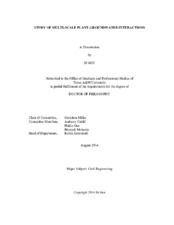| dc.contributor.advisor | Miller, Gretchen | |
| dc.creator | Gou, Si | |
| dc.date.accessioned | 2015-02-05T17:23:03Z | |
| dc.date.available | 2016-08-01T05:30:16Z | |
| dc.date.created | 2014-08 | |
| dc.date.issued | 2014-05-30 | |
| dc.date.submitted | August 2014 | |
| dc.identifier.uri | https://hdl.handle.net/1969.1/153271 | |
| dc.description.abstract | Groundwater serves as one of the main and reliable water sources for human-being and groundwater dependent ecosystems (GDEs). GDEs are threatened by insufficient groundwater supply, due to increasing groundwater extraction and climate change. Sustainable groundwater management should address the water needs for both human and ecosystems, which requires a better understanding of the complex interactions between GDEs and groundwater. This dissertation examines plant-groundwater interactions and their implications at a range of scales.
At the plant scale (~1 m^(2)), a physically-based model was developed to explore the hydraulic mechanisms of plant groundwater use. New functions of root water uptake and hydraulic redistribution (HR) in the model were driven by the potential gradients along the groundwater-soil-plant-atmosphere continuum, and a new water stress function was based on the linear relationship between stomatal conductance and root hydraulic conductance. These functions were further incorporated into a groundwater-land surface model, ParFlow.CLM, to develop a spatial distributed ecohydrological model at the stand scale (~1000 m^(2)). The modified ParFlow.CLM was used to conduct a 8-year simulation with half hourly time step at a AmeriFlux oak savanna site in California. It performed well when simulating daily, hourly, and spatial changes of water and energy dynamics. It captured the seasonal shift of plant water source from soil water during the wet season to groundwater during the dry season. The model simulated both hydraulic lift and hydraulic descent during oak active and dormant seasons. The model suggested that HR at this site was a mechanism for oaks to compete for water with annual grasses.
At the regional scale (~1000 km^(2)), a method was proposed to identify vegetative GDEs using remote sensing data and to generate a detailed GDEs map for the Edwards aquifer region in Texas. This method used Landsat ETM+ and MODIS images to track the changes of NDVI for each vegetation pixel under different precipitation conditions. The NDVI dynamics were used to identify the vegetation with high potential to use groundwater. The method produces a detailed map of potential GDEs, which represents the first step towards sustainable water management associated with these ecosystems. | en |
| dc.format.mimetype | application/pdf | |
| dc.language.iso | en | |
| dc.subject | Plant-Groundwater Interaction | en |
| dc.subject | Groundwater Dependent Ecosystems | en |
| dc.subject | Scales | en |
| dc.subject | Modeling | en |
| dc.subject | Remote Sensing | en |
| dc.title | Study of Multi-Scale Plant-Groundwater Interactions | en |
| dc.type | Thesis | en |
| thesis.degree.department | Civil Engineering | en |
| thesis.degree.discipline | Civil Engineering | en |
| thesis.degree.grantor | Texas A & M University | en |
| thesis.degree.name | Doctor of Philosophy | en |
| thesis.degree.level | Doctoral | en |
| dc.contributor.committeeMember | Cahill, Anthony | |
| dc.contributor.committeeMember | Gao, Huilin | |
| dc.contributor.committeeMember | Mohanty, Binayak | |
| dc.type.material | text | en |
| dc.date.updated | 2015-02-05T17:23:03Z | |
| local.embargo.terms | 2016-08-01 | |
| local.etdauthor.orcid | 0000-0002-7204-0453 | |


